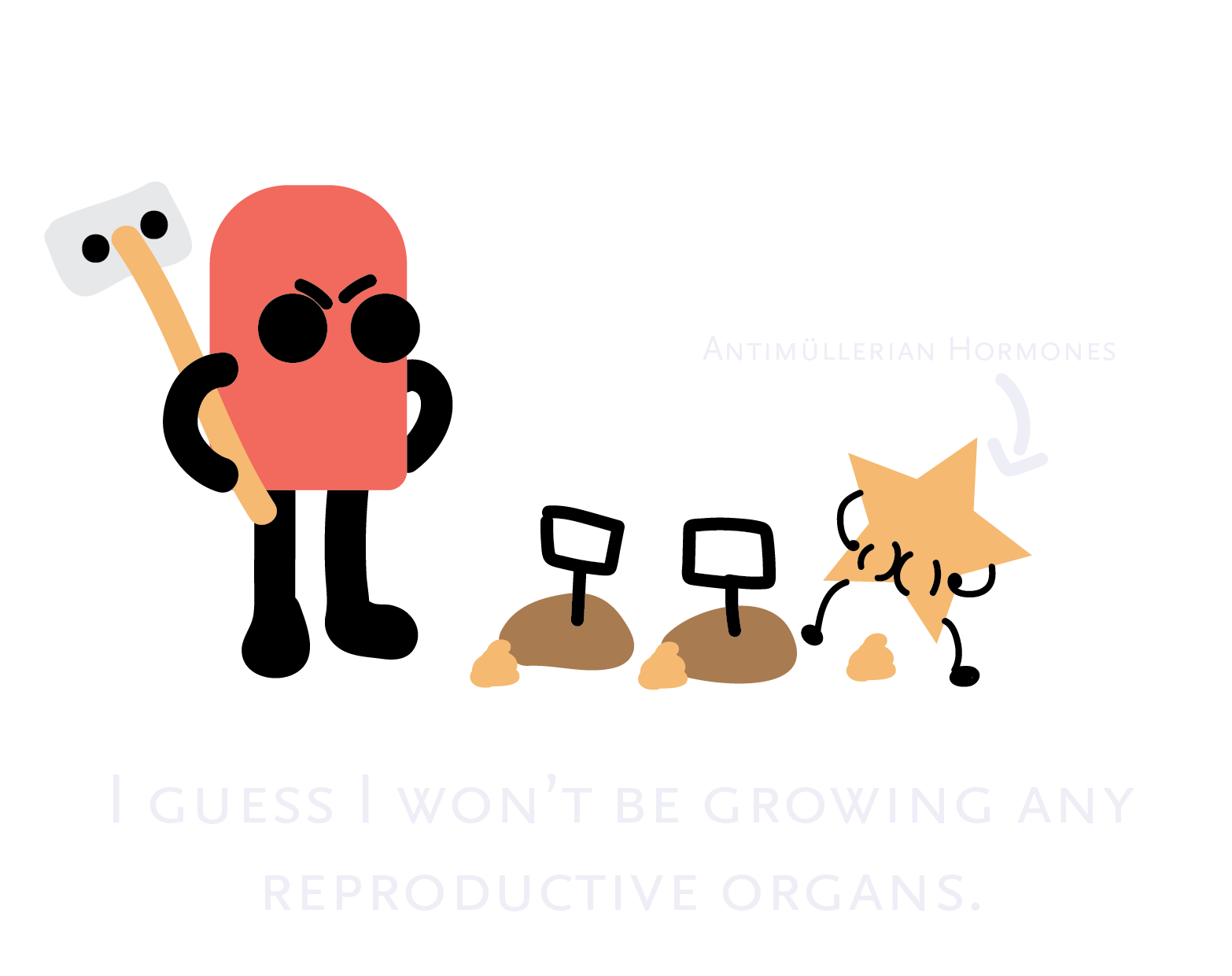Talk Nerdy to Me
How can genitals be ambiguous?
Step one is to understand that biological sex is a spectrum. Step two is to stop thinking of male and female external sex organs as being so different from each other.
Depending on the levels of androgen that the body understands, the body can can create a beautiful spectrum between what is classically though of as male and female, and it’s perfectly natural. It’s just tissue reacting to different levels of hormones, nothing more, and nothing less. Watch the animation below to see how more or less androgen can change how we look.
If female is the default, and AIS bodies don’t understand androgens, then why do people with AIS have testis and not ovaries?
National Geographic Says:
As embryos, our gonads aren’t specific to either gender. Their default course is a female one, but they can be diverted through the action of a gene called SRY that sits on the Y chromosome. SRY activates another gene called Sox9, which sets off a chain reaction of flicked genetic switches. The result is that premature gonads develop into testes. Without SRY or Sox9, you get ovaries instead.
People with AIS have the SRY gene on their Y chromosome and it tells the gonads to develop into testes. With the body being unable to understand androgens, though, the body is unable to masculinize and we stay the default - female.
Why didn’t the female reproductive organs grow?
Antimüllerian Hormones. Those Jerks.
While people with Androgen Insensitivity Syndrome have problems understanding androgens, their bodies have no problem understanding antimüllerian hormones. Antimüllerian hormones actively stop the development of fallopian tubes, uterus, and the upper vagina. (source)
Can someone explain to me how chromosomes work again?
Sure! The human body has 46 total chromosomes.
There are 23 Chromosomes from the father. The 23rd could be an “X” or a “Y.”
There are 23 Chromosomes from the mother. The 23rd could be an “X” or an “X.”
But what happens if there is a genetic mutation on one of the mother’s X chromosomes?
You have a 1/4 chance of 46 XY male.
You have a 1/4 chance of 46 XX female.
You have a 1/4 chance of 46 XX female carrier. She can pass on AIS to the next generation.
You have a 1/4 chance of 46 XY female. That’s Androgen Insensitivity Syndrome!
What does all of this medical Jargon even mean?
Have you started googling “Androgen Insensitivity Syndrome” as soon as the doctor told you about your child, only to come up with these scholarly articles, and realized that you slept through biology? Or if you paid attention, that it would take a doctored to get through just the abstract? Here’s an example:
Androgen insensitivity syndrome in its complete form is a disorder of hormone resistance characterised by a female phenotype in an individual with an XY karyotype and testes producing age-appropriate normal concentrations of androgens. Pathogenesis is the result of mutations in the X-linked androgen receptor gene, which encodes for the ligand-activated androgen receptor—a transcription factor and member of the nuclear receptor superfamily.
That’s not an easy read for a non-scientist. Here’s plain english:
People have Complete AIS when they look female, have XY chromosomes, have gonads producing male hormones, but their bodies can’t understand male hormones.
Below is a list of medical jargon and what they mean in plain english because you shouldn’t have to have a medical degree to care for your child.
Medical Terms
46 XY Female - People with AIS who identify as females with XY chromosomes.
Ambiguous Genitalia – Unable to tell if the genitals are a penis or a clitoris. The urethra may be in a different locations along the shaft of the penis or clitoris. The vulva or the scrotum may be open or stitched together.
amenorrhea – the absence of a period
Androgens – Male Hormones. This includes testosterone.
Androgen Insensitivity - When the body doesn’t understand male hormones.
Antimüllerian Hormone - This hormone stops female reproductive organ development.
Cervix - Tissue that connects the vagina to the uterus. People with AIS do not have a cervix.
Chromosomes - The little proteins that make up DNA. Humans have 23 pairs of them, making up a total of 46.
Estrogen - a hormone. In AIS, the body understand estrogen. Some testosterone is converted into estrogen in the body.
Fallopian Tubes - The tubes connecting the ovaries to the uterus. People with AIS do not have fallopian tubes.
Gonads - The gender neutral term for reproductive organs (testicles and ovaries).
Gonadal Dysgenesis - This is when the gonads do not form correctly and don’t have the ability to reproduce.
Hormone-resistance - This is when the cells in your body do not respond to hormones like androgens.
inguinal hernia repair - This is when testis in the inguinal canal (lower pelvis) cause a hernia, and a doctor (urologist) goes in and remove the gonad.
Ovaries - This is what the female gonad is called. People with AIS do not have Ovaries.
Phenotype – Observable Characteristics. Example: If your daughter has CAIS, they are observed to have the body of a female.
Secondary Sexual Characteristics - Features that appear during puberty, such as breasts and curves. Due to AIS, body hair may be sparse.
Streak Gonads - underdeveloped gonads.
Testes - This is what the male gonad is called. People with AIS have testes.
Testosterone - An androgen. This hormone increases bone density in men.
Uterus - The womb. People with AIS do not have a Uterus.
Vaginal Agenesis - The vagina may not form for people with AIS.
Vaginal Length - The vaginal length may be shortened for people with AIS.
If the body produces testosterone, why take estrogen for hormone replacement?
According to the study below, if you have CAIS, you can take either testosterone or estrogen for hormone replacement without any ill side effects. Not included in the study, though, is that if you are concerned about bone density, you should take estrogen.






